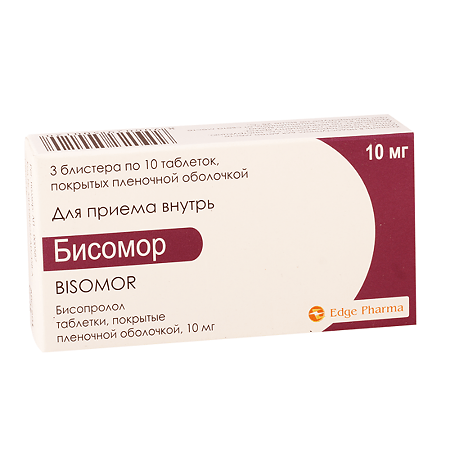No products in the cart.
Bisomor, 10 mg 30 pcs.
€1.00
Out of stock
(E-mail when Stock is available)
Description Pharmacotherapeutic group: Beta1-adrenoblocker selective
ATC:
C.07.A.B Selective beta1-adrenoblockers
C.07.A.B.07 Bisoprolol
Pharmacodynamics:
A selective beta1-adrenoblocker, without intrinsic sympathomimetic activity, has no membrane-stabilizing effect.
Reduces plasma renin activity, decreases myocardial oxygen demand, decreases heart rate (HR). It has antihypertensive, antiarrhythmic and antianginal effects. By blocking in low doses beta1-adrenoceptors of heart, decreases catecholamine-stimulated formation of cyclic adenosine monophosphate (cAMP) from adenosine triphosphate (ATP), reduces intracellular calcium ions flow, has negative chrono-, dromo-, batmo- and inotropic effects (inhibits conduction and excitability, slows atrioventricular (AV) conduction). When increasing the dose above the therapeutic dose it has beta2-adrenoblocking action.
Total peripheral vascular resistance at the beginning of the drug use, during the first 24 hours it slightly increases (as a result of reciprocal increase of activity of alpha-adrenoreceptors and decrease of beta2-adrenoreceptors stimulation) that after 1-3 days returns to the basic value, and during the long use decreases.
Antihypertensive effect is associated with decreased minute blood volume, sympathetic stimulation of peripheral vessels, decreased activity of the sympathoadrenal system. (SAS) (of great importance for patients with initial renin hypersecretion), restoration of sensitivity in response to decreased blood pressure (BP) and the effect on the central nervous system (CNS). In arterial hypertension the effect occurs within 2-5 days/stable action – within 1-2 months.
Antianginal action is caused by decrease of myocardial oxygen demand as a result of decrease of contractility and other myocardial functions, prolongation of diastole, improvement of myocardial perfusion. Due to increased end diastolic pressure in the left ventricle and increased stretching of ventricular muscle fibers may increase myocardial oxygen demand, especially in patients with chronic heart failure (CHF).
Antiarrhythmic action is caused by the removal of arrhythmogenic factors (tachycardia, increased activity of the sympathetic nervous system, increased content of CAMF, arterial hypertension), the decrease of spontaneous excitation rate of sinus and ectopic pacemakers and AV conduction slowing (mainly in antegrade and, to a lesser extent, in retrograde direction via AV node) and by additional pathways.
In contrast to non-selective beta-adrenoblockers when administered in medium therapeutic doses it has less pronounced effect on the organs containing beta2-adrenoreceptors (pancreas, skeletal muscles, smooth muscles of peripheral arteries, bronchi and uterus) and on carbohydrate metabolism, does not cause sodium ion retention in the body.
Pharmacokinetics:
Absorption
Bisoprolol is almost completely (> 90%) absorbed from the gastrointestinal tract (GIT), food intake does not affect absorption. Bisoprolol exhibits linear kinetics, with plasma concentrations proportional to the administered dose ranging from 5 to 20 mg. Maximum bisoprolol plasma concentration (Cmax) is reached after 2-3 h.
Distribution
The volume of distribution (Vd) is 3.5 l/kg. The binding to plasma proteins is about 30%.
Metabolism
Metabolized by the oxidative pathway without subsequent conjugation; slightly metabolized during “primary passage” through the liver (about 10-15%). All metabolites are polar. The major metabolites detected in plasma and urine have no pharmacological activity. The data obtained from experiments with human liver microsomes in vitro show that bisoprolol is metabolized primarily with the participation of CYP3A4 isoenzyme (about 95%), and CYP2D6 isoenzyme plays only a small role.
Excretion
Bisoprolol is excreted in two ways, 50% of the dose is metabolized in the liver with the formation of inactive metabolites. About 98% is excreted by the kidneys, of which 50% – unchanged, less than 2% – through the intestine (with bile). Total clearance is 12-18 l/h, while renal clearance is 8-11 l/h; elimination half-life (T1/2) is 10-12 hours. Hematoencephalic and placental barrier permeability is low. Bisoprolol pharmacokinetics is linear and independent of age. In patients with CHF, the plasma concentration of bisoprolol is higher and the T1/2 is longer compared to healthy volunteers.
Indications
Indications
Active ingredient
Active ingredient
Composition
Composition
How to take, the dosage
How to take, the dosage
Interaction
Interaction
Special Instructions
Special Instructions
Contraindications
Contraindications
Side effects
Side effects
Overdose
Overdose
Pregnancy use
Pregnancy use
Similarities
Similarities
Additional information
| Shelf life | 3 years. Do not take after the expiration date shown on the package. |
|---|---|
| Conditions of storage | In a dry, light-protected place at a temperature not exceeding 25 ° C. Keep out of reach of children. |
| Manufacturer | Edge Pharma Private Limited, India |
| Medication form | pills |
| Brand | Edge Pharma Private Limited |
Related products
Buy Bisomor, 10 mg 30 pcs. with delivery to USA, UK, Europe and over 120 other countries.














